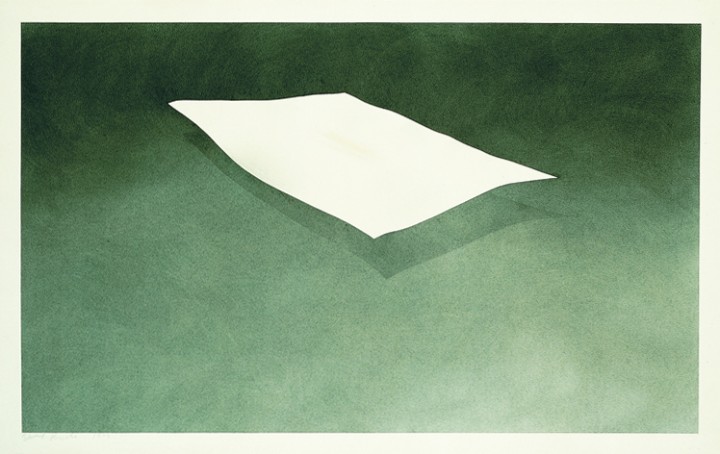
Before an artist draws or a writer writes, s/he confronts a blank sheet of paper, which awaits the marks that transform it into a work conveying creative thought. In Art=Text=Art, several artists have created intriguing works that deliberately exploit the paper’s expanse of white, unmarked space as a meaningful element of the overall composition. Artists leave areas blank to mediate between “absence” and “presence.” Determining what to draw, or where to place a line or other mark, is as important as deciding which areas to leave pristine. Blank areas in drawings are not empty.
Consider works by Ed Ruscha, Robert Barry, John Fraser, Bronlyn Jones, or Jill O’Bryan.
How does each artist use the white of the paper? And to what purpose? What does each artist’s use of the white of the paper suggest to you? How are the white, unmarked areas of these works significant? Please share your thoughts about these drawings or about other drawings in the exhibition that use the blank space of the paper in interesting ways. In Bronlyn Jones’s Erasure List (2009), she offers for pondering: What is left out, What is unnecessary, and What is left unsaid.
To launch the Art=Text=Art discussion section, we offer the concept of tabula rasa [blank slate] and the “blank” parts of drawings as a catalyst for your ideas.
Marilyn Symmes is the Morse Research Center for Graphic Arts Director & Curator of Prints and Drawings at the Zimmerli Art Museum at Rutgers University, New Brunswick, New Jersey. In addition to overseeing the Zimmerli’s installation of the Art=Text=Art exhibition in 2012, she organized the 2011-12 traveling exhibition Dancing with the Dark: Joan Snyder Prints 1963-2010. Other Zimmerli exhibitions she realized include: with the help of Rutgers University Art History graduate students, Pop Art and After: Prints and Popular Culture (2008); Jolán Gross-Bettelheim: An American Printmaker in an Age of Progress (2011); Aspects of Architecture: The Prints of John Taylor Arms (2012); Lynd Ward Draws Stories (2012); and Stars: Contemporary Prints by Derrière L’Étoile Studio, New York (2013). From the 1970s to 2002, Symmes held graphic arts curatorial posts at the Smith College Museum of Art, Northampton, Massachusetts; Detroit Institute of Arts; the Toledo Museum of Art, Ohio; and the Smithsonian’s Cooper-Hewitt National Design Museum, New York, where she organized many Old Master to contemporary graphic arts exhibitions. In addition to the monograph Dancing with the Dark: Joan Snyder Prints 1963-2010 (2011), her publications include Impressions of New York, Prints from the New-York Historical Society (2005) and Fountains: Splash and Spectacle, Water and Design from the Renaissance to the Present (1998). Symmes has also published numerous catalogues and articles on prints, drawings, and artist illustrated books. Currently serving on the advisory board of the Lower East Side Printshop, New York, and the National Endowment for the Arts International Advisory Panel, Washington, DC, Symmes has previously served on the boards of the Print Council of America and the International Confederation of Architectural Museums. She has a BA in Art History from Stanford University, Stanford, California; and an MA in Art History and Museum Practice from the University of Michigan, Ann Arbor.